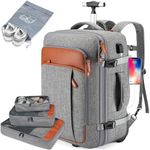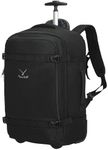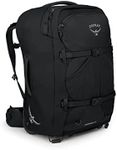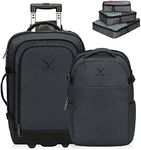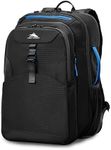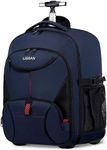Buying Guide for the Best Travel Backpack With Wheels
Choosing a travel backpack with wheels is all about finding the right balance between comfort, convenience, and capacity. These bags are designed to give you the flexibility of carrying your belongings on your back or rolling them along, making them ideal for a variety of travel situations. To pick the best one for you, it's important to consider how you'll use the backpack most often—whether you'll be navigating airports, city streets, or rougher terrain—and what features will make your journey easier and more enjoyable.Capacity (Liters)Capacity refers to how much the backpack can hold, usually measured in liters. This is important because it determines how much you can pack and how heavy the bag will be when full. Smaller capacities (under 40 liters) are great for short trips or as carry-on luggage, while medium capacities (40-60 liters) suit longer trips or those who pack a bit more. Larger capacities (over 60 liters) are best for extended travel or if you need to carry bulky items. Think about the length of your trips and your packing style to choose the right size for your needs.
Wheel Quality and TypeThe wheels on a travel backpack are crucial for smooth rolling and durability. Some backpacks have small, recessed wheels that are good for city travel and smooth surfaces, while others have larger, rugged wheels designed for rougher terrain. If you expect to roll your bag over uneven ground, look for larger, more durable wheels. If you'll mostly be in airports or hotels, smaller wheels may be sufficient. Consider where you'll be traveling most often to decide which wheel type is best for you.
Backpack Straps and ComfortSince you'll sometimes carry the bag on your back, the quality of the straps and back padding is important for comfort. Look for padded, adjustable shoulder straps and a padded back panel. Some backpacks also have a hip belt to help distribute weight. If you plan to carry the bag for longer periods, prioritize comfort features. If you'll mostly roll the bag, basic straps may be enough.
Handle DesignThe handle allows you to pull the backpack like a suitcase. Telescoping handles that can be adjusted to different heights are more comfortable for users of different sizes. Check that the handle feels sturdy and extends smoothly. If you'll be rolling the bag a lot, a strong, comfortable handle is essential. If you'll carry it more often, the handle may be less important.
Weight of the BackpackThe empty weight of the backpack affects how easy it is to carry or roll, especially when fully packed. Lighter backpacks are easier to handle but may have fewer features or less durability. Heavier backpacks might offer more protection or organization but can be tiring to carry. Consider your own strength and how much you'll need to lift or carry the bag when choosing the right weight.
Compartments and OrganizationThe number and type of compartments help you organize your belongings. Some backpacks have multiple pockets, laptop sleeves, and separate sections for shoes or dirty clothes. If you like to keep things organized and easy to access, look for a bag with more compartments. If you prefer a simple, open space for packing, fewer compartments may be better.
Material and DurabilityThe material of the backpack affects its durability and weather resistance. Common materials include nylon, polyester, and canvas. Water-resistant or waterproof materials are helpful if you'll be traveling in wet conditions. If you travel frequently or in tough environments, choose a backpack made from strong, durable materials. For occasional or light travel, a lighter material may be sufficient.
